10 Things We Learned From WWE Royal Rumble 1991
Sgt. Slaughter beats Ultimate Warrior for the WWF Championship...
Professional wrestling has never shied away from playing up geopolitical disputes and foreign rivalries in its storytelling, and WWE would "go there" in the early-nineties with one of their more questionable tales. Longtime proud American Sgt. Slaughter was suddenly aligned with Saddam Hussein and Iraq during the run-up to what would become known as Operation Desert Storm. The 1991 Royal Rumble would take place four days after the UN Security Council-mandated deadline for Iraq to withdraw from Kuwait. Naturally, the pro-Iraq Slaughter would be challenging for the WWE Championship at the pay-per-view.
You didn't need 20/20 vision to see where this was going - Slaughter downed The Ultimate Warrior to capture the WWE Championship, while American hero Hulk Hogan went on to win the Royal Rumble match. Slaughter and Hogan would find themselves on a collision course for WrestleMania 7, paralleling the conflict over in the Gulf region. The decision to book this storyline (at a time when soldiers were preparing to face a potential, and very real, life-and-death situation) would earn much derision and criticism.
The 1991 Royal Rumble was a very good show otherwise, highlighted by damn good wrestling in the undercard (namely The Rockers vs. The Orient Express, a lost classic), and a fun-enough Rumble match. Sadly, the trivializing of real world conflict is what gets remembered the most.
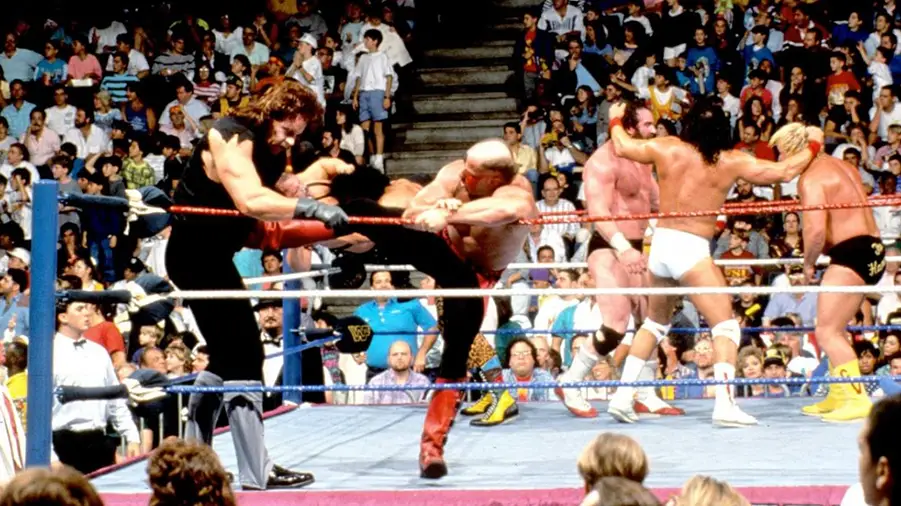 WWE
WWE
The 1991 Royal Rumble was one of two Rumbles (1994 being the other) to have taken place on a Saturday instead of the traditional Sunday. In fact, the two events are the only American WWE pay-per-views that have occurred on Saturdays, period, and it wasn't a cosmetic decision on the part of WWE to do so.
Typically, WWE holds the Rumble on the vacant Sunday between the NFL Conference Championship games and the Super Bowl, to avoid competition with such high-profile sporting events. In some years, such was the case with 1991, the NFL schedule didn't allow for the week off, holding the Super Bowl one week following the conference title games. WWE, trying to avoid the unnecessary competition, opted to hold the show on the Saturday night before the Championship round games.
 WWE
WWE
WWE knew exactly what they were doing when they sent the red, white, and blue-clad Ultimate Warrior out to drop the WWE Championship to the pro-Hussein Sgt. Slaughter, and there were reportedly many within WWE unhappy with the plan. Dave Meltzer of The Wrestling Observer noted that there were those in the locker room and office considering resigning due to the angle. Bret Hart noted in his memoirs that many in the locker room thought that wrestling was too cartoonish to be portraying something with the grave consequences of real-life war.
One person who washed their hands of WWE as a result of the storyline was veteran NBC sportscaster Bob Costas, who had previously guested on WWE events in the mid-eighties. Costas was set to take part in a light-hearted skit at WrestleMania 7, and would ultimately pull out of the event in early March, saying, "Under the circumstances, I don't think (doing the show) would be in the best of taste."
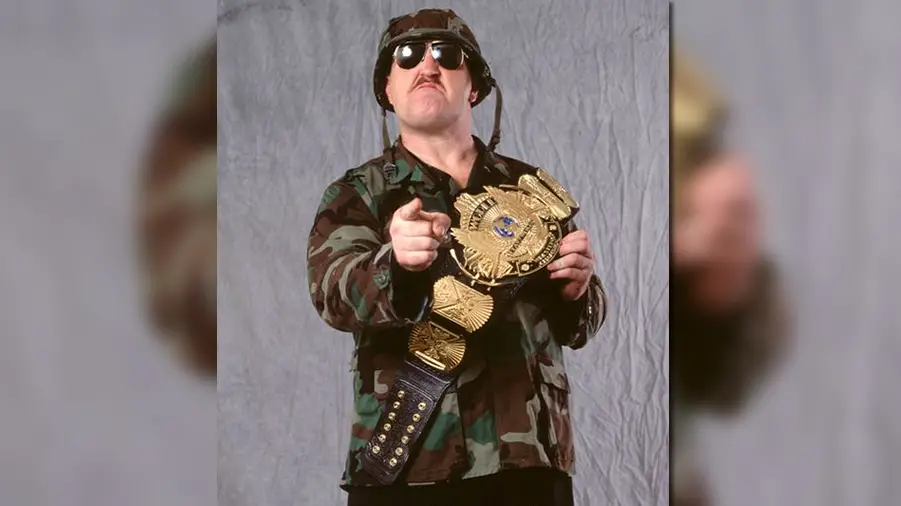 WWE
WWE
The Seattle crowd getting hot at Elias for mocking their basketball misfortunes was mere child's play compared to the atmosphere inside the Miami Arena after Slaughter pinned Warrior to capture the belt. Slaughter would tell stories of having his life threatened by irate and nutty fans during his time playing an Iraqi sympathizer, and there were concerns over his safety.
On the night of the Royal Rumble, Slaughter reportedly stayed inside the Miami Arena until three in the morning Sunday, more than four hours after the show had ended. The mood inside the building was such that there were fears that some angry wackjob could be waiting for Slaughter out in the parking lot. It was only then that it was deemed safe enough for Slaughter to leave the building.
 WWE
WWE
The Mountie and Koko B. Ware had the unenviable task of trying to follow Slaughter vs. Warrior, but they really only needed to act as a time killer. Trying to move the action along from Slaughter's maddening victory was a wise move, and the two had a nine-minute filler match that was mostly basic, a means of letting Jacques Rougeau flesh out his new gimmick a little bit more.
The match was basically a last-minute addition to the show, and didn't even make the initial VHS release of the pay-per-view. There wasn't anything memorable about it anyhow, but its exclusion probably irked a few completists out there. Later versions of the event, such as the 2007 DVD release and the WWE Network version, restored it as part of the complete version of the show.
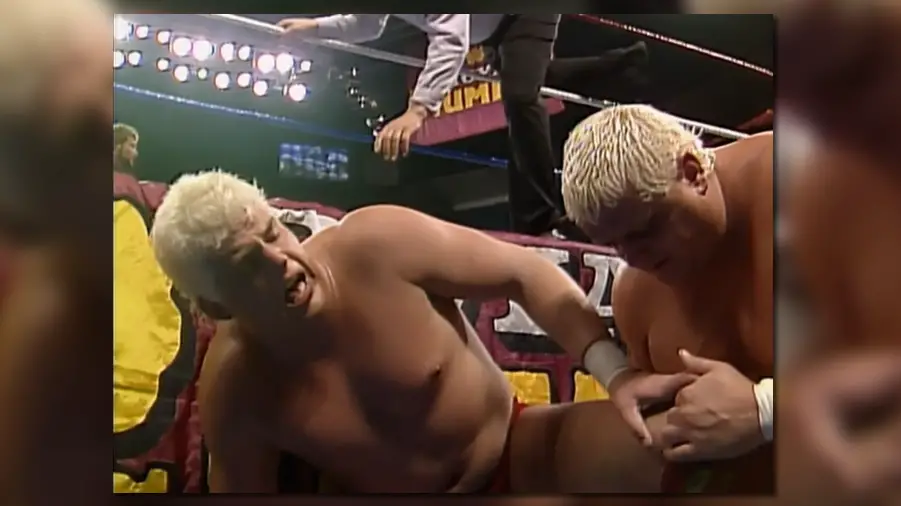 WWE
WWE
One of the absolute highlights of the event was the babyface turn of everyone's favourite convention attraction, Virgil. For some time, Ted DiBiase had been extra abusive toward his muted manservant, and it came to a head after the two defeated Dusty and Dustin Rhodes at the 1991 Rumble. Virgil walloped DiBiase with the Million Dollar belt in the post-match scene, drawing one of the biggest pops of his career.
As for the Rhodes' family, both father and son would depart immediately after the show. Dusty already had a job waiting for him back in WCW, where he would re-emerge 11 days later as part of the booking committee, his days as a full-time wrestler over. Dustin would follow, spending four years in WCW as a consistently-pushed singles competitor before winding up back in WWE in 1995, with a name you'd never forget.
 PWI
PWI
One of the scheduled entrants for the Rumble match was none other than the "Eighth Wonder of the World", Andre the Giant. Andre's WWE swansong had taken place at WrestleMania 6, but the company announced his name among the Rumble field in late-1990. Andre even shot promos regarding his participation in the match. WWE Magazine even listed Andre as an entrant in the match's preview.
Ultimately, Andre would have to bow out of the match due to health reasons. At age 44, with several years of clear deterioration in his wake, it was hard to imagine Andre taking a bump over the top rope for his elimination. Three weeks before the event, it was announced on WWE TV that Andre pulled out due to injuries.
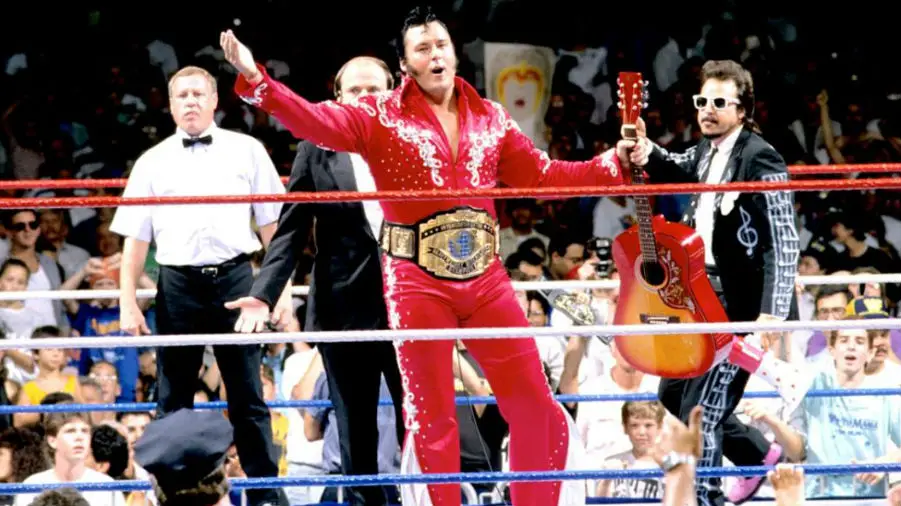 WWE
WWE
The Nasty Boys arrived in WWE in December 1990, after several acclaimed performances in WCW working against The Steiner Brothers. The two were not initially scheduled to be a part of the Royal Rumble, but Brian Knobbs wound up in the match anyway, coming in third place overall. Jerry Sags, meanwhile, worked the dark match against journeyman Sam Houston.
Knobbs' participation in the Rumble was actually as a fill-in, taking the place of The Honky Tonk Man. Honky quit the company shortly after Christmas 1990, by which time he was mostly working as a colour commentator on WWE Superstars. Honky's pre-taped performances continued to air up until Royal Rumble Saturday, with Knobbs taking his spot that night on the pay-per-view telecast.
 WWE
WWE
There were a number of "iron men" in the 1991 Rumble match, with 10 different men breaching the 20-minute mark, and four of them making it past a half hour. The man who posted the second-longest duration was Greg "The Hammer" Valentine, who survived a shade over 44 minutes from the number three draw.
According to Dave Meltzer in his write-up of the show, Valentine was actually being punished by having to work for such a long period of time. Valentine, with no formal WWE contract in place, had taken dates in late-1990 with Herb Abrams' UWF promotion that January, and Vince McMahon was reportedly none too pleased with Valentine's decision to work those shows. Valentine would later note in a shoot that he jumped back to WWE after working those January UWF cards, and Abrams cancelled his checks as retaliation. Seems "The Hammer" just couldn't win.
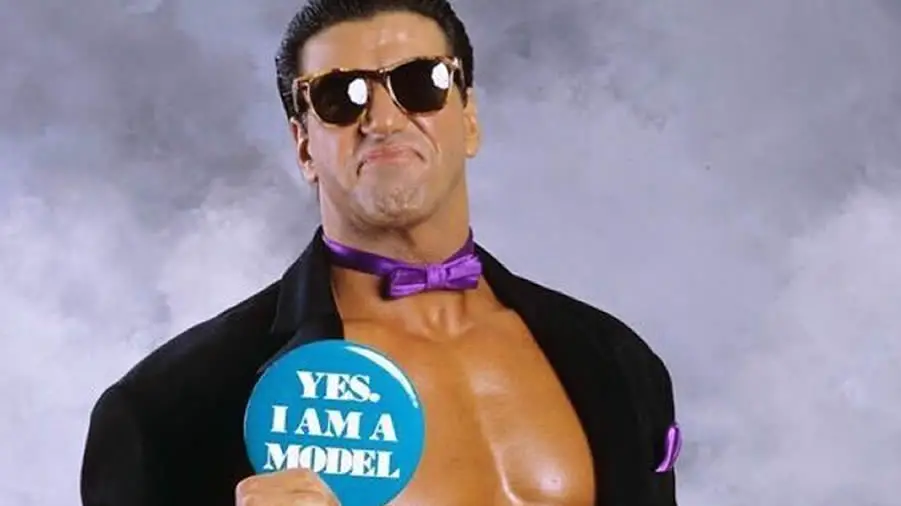 WWE
WWE
Fans watching the Rumble match had to get used to seeing a tanned and fit wrestler in purple trunks on their screen for much of the match. Rick "The Model" Martel was at the peak of his days as a narcissistic villain, and would post the longest match time in a Rumble that saw many wrestlers log a good share of minutes.
In all, Martel set a new Rumble record by lasting 52 minutes and 17 seconds, making him the first man to pass the 50 minute mark in Rumble history. Martel would record four eliminations (tied for second most with Earthquake), and came in fifth place after being clotheslined out by Davey Boy Smith, who himself survived for more than 36 minutes.
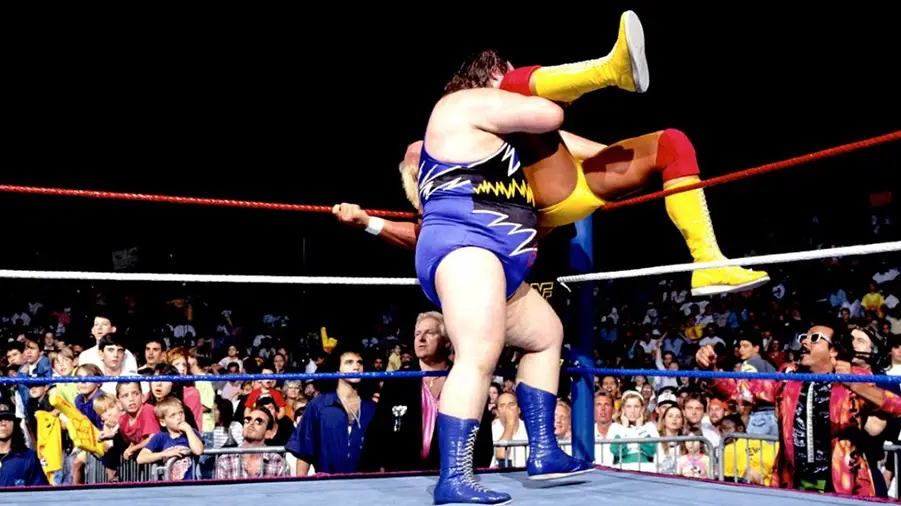 WWE
WWE
Okay, wrap your heads around this one if you can. The 1990 Royal Rumble did approximately 260,000 buys. Two years later, the 1992 version of the show would do roughly the same amount, 260,000. Based on how trends tend to go, you'd think that the 1991 Royal Rumble would fall in line somewhere around there, right? Think again.
The 1991 Rumble pulled in a staggering 440,000 buys, with the Saturday night placement having no negative effect on the show at all. In fact, the 1991 show would mark one of three Rumbles (1997 and 2003 being the others) that did a greater buyrate than the WrestleMania that followed. The Slaughter/Hogan angle would manage just 400,000 buys come 'Mania Sunday, narrowly aced out by the 30-man brawl that preceded it.
You didn't need 20/20 vision to see where this was going - Slaughter downed The Ultimate Warrior to capture the WWE Championship, while American hero Hulk Hogan went on to win the Royal Rumble match. Slaughter and Hogan would find themselves on a collision course for WrestleMania 7, paralleling the conflict over in the Gulf region. The decision to book this storyline (at a time when soldiers were preparing to face a potential, and very real, life-and-death situation) would earn much derision and criticism.
The 1991 Royal Rumble was a very good show otherwise, highlighted by damn good wrestling in the undercard (namely The Rockers vs. The Orient Express, a lost classic), and a fun-enough Rumble match. Sadly, the trivializing of real world conflict is what gets remembered the most.
10. Live From Miami, It's Saturday Night!
 WWE
WWEThe 1991 Royal Rumble was one of two Rumbles (1994 being the other) to have taken place on a Saturday instead of the traditional Sunday. In fact, the two events are the only American WWE pay-per-views that have occurred on Saturdays, period, and it wasn't a cosmetic decision on the part of WWE to do so.
Typically, WWE holds the Rumble on the vacant Sunday between the NFL Conference Championship games and the Super Bowl, to avoid competition with such high-profile sporting events. In some years, such was the case with 1991, the NFL schedule didn't allow for the week off, holding the Super Bowl one week following the conference title games. WWE, trying to avoid the unnecessary competition, opted to hold the show on the Saturday night before the Championship round games.
9. Casualties Of War
 WWE
WWEWWE knew exactly what they were doing when they sent the red, white, and blue-clad Ultimate Warrior out to drop the WWE Championship to the pro-Hussein Sgt. Slaughter, and there were reportedly many within WWE unhappy with the plan. Dave Meltzer of The Wrestling Observer noted that there were those in the locker room and office considering resigning due to the angle. Bret Hart noted in his memoirs that many in the locker room thought that wrestling was too cartoonish to be portraying something with the grave consequences of real-life war.
One person who washed their hands of WWE as a result of the storyline was veteran NBC sportscaster Bob Costas, who had previously guested on WWE events in the mid-eighties. Costas was set to take part in a light-hearted skit at WrestleMania 7, and would ultimately pull out of the event in early March, saying, "Under the circumstances, I don't think (doing the show) would be in the best of taste."
8. Protecting The Champ
 WWE
WWEThe Seattle crowd getting hot at Elias for mocking their basketball misfortunes was mere child's play compared to the atmosphere inside the Miami Arena after Slaughter pinned Warrior to capture the belt. Slaughter would tell stories of having his life threatened by irate and nutty fans during his time playing an Iraqi sympathizer, and there were concerns over his safety.
On the night of the Royal Rumble, Slaughter reportedly stayed inside the Miami Arena until three in the morning Sunday, more than four hours after the show had ended. The mood inside the building was such that there were fears that some angry wackjob could be waiting for Slaughter out in the parking lot. It was only then that it was deemed safe enough for Slaughter to leave the building.
7. Cutting Room Floor
 WWE
WWEThe Mountie and Koko B. Ware had the unenviable task of trying to follow Slaughter vs. Warrior, but they really only needed to act as a time killer. Trying to move the action along from Slaughter's maddening victory was a wise move, and the two had a nine-minute filler match that was mostly basic, a means of letting Jacques Rougeau flesh out his new gimmick a little bit more.
The match was basically a last-minute addition to the show, and didn't even make the initial VHS release of the pay-per-view. There wasn't anything memorable about it anyhow, but its exclusion probably irked a few completists out there. Later versions of the event, such as the 2007 DVD release and the WWE Network version, restored it as part of the complete version of the show.
6. Dusts Settled
 WWE
WWEOne of the absolute highlights of the event was the babyface turn of everyone's favourite convention attraction, Virgil. For some time, Ted DiBiase had been extra abusive toward his muted manservant, and it came to a head after the two defeated Dusty and Dustin Rhodes at the 1991 Rumble. Virgil walloped DiBiase with the Million Dollar belt in the post-match scene, drawing one of the biggest pops of his career.
As for the Rhodes' family, both father and son would depart immediately after the show. Dusty already had a job waiting for him back in WCW, where he would re-emerge 11 days later as part of the booking committee, his days as a full-time wrestler over. Dustin would follow, spending four years in WCW as a consistently-pushed singles competitor before winding up back in WWE in 1995, with a name you'd never forget.
5. King Of Battle Royals
 PWI
PWIOne of the scheduled entrants for the Rumble match was none other than the "Eighth Wonder of the World", Andre the Giant. Andre's WWE swansong had taken place at WrestleMania 6, but the company announced his name among the Rumble field in late-1990. Andre even shot promos regarding his participation in the match. WWE Magazine even listed Andre as an entrant in the match's preview.
Ultimately, Andre would have to bow out of the match due to health reasons. At age 44, with several years of clear deterioration in his wake, it was hard to imagine Andre taking a bump over the top rope for his elimination. Three weeks before the event, it was announced on WWE TV that Andre pulled out due to injuries.
4. Nasty Surprise
 WWE
WWEThe Nasty Boys arrived in WWE in December 1990, after several acclaimed performances in WCW working against The Steiner Brothers. The two were not initially scheduled to be a part of the Royal Rumble, but Brian Knobbs wound up in the match anyway, coming in third place overall. Jerry Sags, meanwhile, worked the dark match against journeyman Sam Houston.
Knobbs' participation in the Rumble was actually as a fill-in, taking the place of The Honky Tonk Man. Honky quit the company shortly after Christmas 1990, by which time he was mostly working as a colour commentator on WWE Superstars. Honky's pre-taped performances continued to air up until Royal Rumble Saturday, with Knobbs taking his spot that night on the pay-per-view telecast.
3. Extra Hammer Time
 WWE
WWEThere were a number of "iron men" in the 1991 Rumble match, with 10 different men breaching the 20-minute mark, and four of them making it past a half hour. The man who posted the second-longest duration was Greg "The Hammer" Valentine, who survived a shade over 44 minutes from the number three draw.
According to Dave Meltzer in his write-up of the show, Valentine was actually being punished by having to work for such a long period of time. Valentine, with no formal WWE contract in place, had taken dates in late-1990 with Herb Abrams' UWF promotion that January, and Vince McMahon was reportedly none too pleased with Valentine's decision to work those shows. Valentine would later note in a shoot that he jumped back to WWE after working those January UWF cards, and Abrams cancelled his checks as retaliation. Seems "The Hammer" just couldn't win.
2. A Model Of Endurance
 WWE
WWEFans watching the Rumble match had to get used to seeing a tanned and fit wrestler in purple trunks on their screen for much of the match. Rick "The Model" Martel was at the peak of his days as a narcissistic villain, and would post the longest match time in a Rumble that saw many wrestlers log a good share of minutes.
In all, Martel set a new Rumble record by lasting 52 minutes and 17 seconds, making him the first man to pass the 50 minute mark in Rumble history. Martel would record four eliminations (tied for second most with Earthquake), and came in fifth place after being clotheslined out by Davey Boy Smith, who himself survived for more than 36 minutes.
1. Saturday Night Watch Party
 WWE
WWEOkay, wrap your heads around this one if you can. The 1990 Royal Rumble did approximately 260,000 buys. Two years later, the 1992 version of the show would do roughly the same amount, 260,000. Based on how trends tend to go, you'd think that the 1991 Royal Rumble would fall in line somewhere around there, right? Think again.
The 1991 Rumble pulled in a staggering 440,000 buys, with the Saturday night placement having no negative effect on the show at all. In fact, the 1991 show would mark one of three Rumbles (1997 and 2003 being the others) that did a greater buyrate than the WrestleMania that followed. The Slaughter/Hogan angle would manage just 400,000 buys come 'Mania Sunday, narrowly aced out by the 30-man brawl that preceded it.
